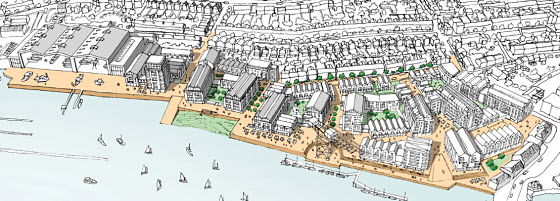|
| Archive of Monthly News Items As previously featured in the History Centre October - December 2021 |
| October 2021 | ||
It's not clear what 'developed in parallel' means, as planning permission would not normally determine if and when a development is undertaken. It seems this unusual condition called for a particular legal agreement between council and developer. In February 2020 we reported this protracted negotiation had reached a conclusion with a signed agreement, but It subsequently emerged there were further delays as disputes arose over legal costs. This too was subsequently settled but months have passed without any indication the developer intended to proceed with what could be a less rewarding option. However, the developer's newly appointed planning agent has now confirmed the phase 4 process is underway, while pointing out there is a great deal of work involved in preparing the application.  | ||
| November 2021 | ||
A couple of years later a geophysical survey of the Medina environs included the Chawton field. Archaeologists were looking forward to getting some indication of the layout of the Roman building. They were shocked to discover there was nothing to indicate any structure at all. There is now a theory that the development of the Island's first railway line, between Newport and Cowes, explains the mystery. Laying the line was dogged with problems at the outset. By 1860 the underfunded project was underway from Newport but excavating difficult land challenged their schedule. By December 1861 they had reached Hunnyhill. It called for a cutting through the highest point. It came as a surprise when excavation of the cutting revealed Roman remains. A local expert was called in to oversee excavations. There were a range of finds, including cremation urns laid in trenches, suggesting a Roman cemetery. Victorian archaeology had limited techniques, so detail of layout and the extent of the cemetery is not clear. The delay in dealing with this discovery was the last thing railway engineers needed. Moreover, it could not have escaped them that the remaining rail route would be along a river bank that would have probably supported shipping and other activities since prehistoric times, not least from the many inlets they would have to pass. They could well strike other historic remains. Speculation has it their worst fears were realised when they uncovered the remains of a major Roman structure near an inlet below the Chawton field. Engineers would have almost certainly recognised the building materials of Roman origin and understood that excavation of the area around a villa could set the rail project back weeks, perhaps calling for a costly detour. Unlike the Hunnyhill situation, they were in an area with no public access. It is suggested they took advantage of the privacy to dig out as much of the Roman material as they could and scatter it across a nearby field, carefully covering it. The fact that nobody recognised the scattering for a over century shows how easy it was to prevent its discovery. There is no evidence to support this theory. It may be there is an alternative explanation, but as yet, it has not been forthcoming. It would probably require substantial excavations to clarify the matter. In recent times traces of Roman industrial activity have been found on the bank of a Medina inlet.  | ||
| December 2021 | ||

There is no other example of this type of kiln anywhere, nor had anything like it ever been patented. It was designed to dry the soft cement mix using waste heat from its integral bottle kilns. It is a previously unknown predecessor to what became the common chamber kiln The heating process employed appears to be highly sophisticated, involving directing the hot gases both via under floor ducts and through the chamber. There are still features that cannot be explained and more work will be required for a full understanding of the structure. The Medina Cement works was no stranger to innovation. In the 1860s it built the nation's first concrete houses at East Cowes. Whatever the outcome of Historic England's deliberations, the Dodnor kiln will remain one of the Island's most unique structures, with an opportunity for further discoveries. | ||